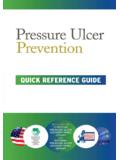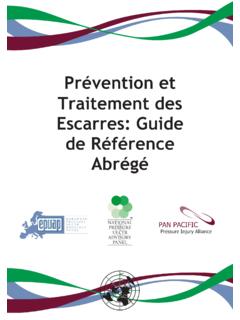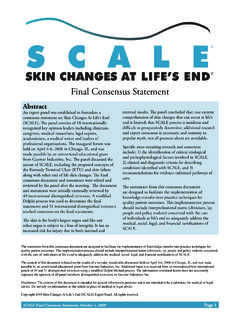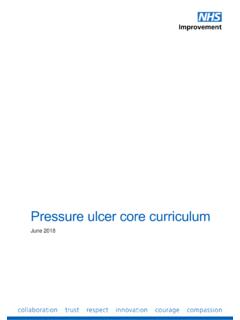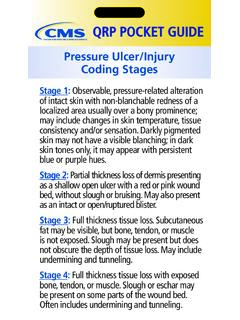Transcription of Quick Reference Guide Prevention - Pressure ulcer
1 Quick Reference Guide Prevention 1 Introduction This Quick Reference Guide summarizes evidence-based guidelines on Pressure ulcer Prevention and treatment. It was developed as a 4-year collaborative effort between the European Pressure ulcer Advisory Panel (EPUAP) and American National Pressure ulcer Advisory Panel (NPUAP).
2 The more comprehensive Clinical Practice Guideline version of the guideline provides a detailed analysis and discussion of available research, critical evaluations of the assumptions and knowledge of the field, a description of the methodology used to develop guideline, and acknowledgments of editors, authors, and other contributors. This Quick Reference Guide contains excerpts from the Clinical Practice Guideline, but users should not rely on these excerpts alone.
3 Printed copies of the English editions of both documents are available through the NPUAP website ( ). The Quick Reference Guide has been translated into several languages; translations are available on the EPUAP website ( ). The goal of this international collaboration was to develop evidence-based recommendations for the Prevention and treatment of Pressure ulcers that could be used by health care professionals throughout the world. An explicit scientific methodology was used to identify and evaluate available research.
4 In the absence of definitive evidence, expert opinion (often supported by indirect evidence and other guidelines) was used to make recommendations. Guideline recommendations were made available to 903 individuals and 146 societies/organizations registered as stakeholders in 63 countries on 6 continents. The final guideline is based on the available research and the accumulated wisdom of the EPUAP, NPUAP, and international stakeholders. Suggested Citation The EPUAP and NPUAP welcome the use and adaptation of the guidelines at a national and local level.
5 However, we request citation as to the source, using the following format: European Pressure ulcer Advisory Panel and National Pressure ulcer Advisory Panel. Prevention and treatment of Pressure ulcers: Quick Reference Guide . Washington DC: National Pressure ulcer Advisory Panel; 2009. Quick Reference Guide Prevention 2 International Guideline Prevention of Pressure Ulcers.
6 Quick Reference Guide European Pressure ulcer Advisory Panel & National Pressure ulcer Advisory Panel 2009 Additional printed copies are available through the National Pressure ulcer Advisory Panel ( ) Quick Reference Guide Prevention 3 Limitations and Appropriate Use of This Guideline Guidelines are systematically developed statements to assist practitioner and patient decisions about appropriate health care for specific clinical
7 Conditions. The recommendations may not be appropriate for use in all circumstances. The decision to adopt any particular recommendation must be made by the health care professional in light of available resources and circumstances presented by the individual patient. Nothing contained in this guideline is to be considered medical advice for specific cases. Because of the rigorous methodology used to develop this guideline, the NPUAP and EPUAP believe that the research supporting these recommendations is reliable and accurate.
8 However, we do not guarantee the reliability and accuracy of individual studies referenced in this document. This guideline and any recommendations herein are intended for educational and informational purposes only. This guideline contains information that was accurate at the time of publication. Research and technology change rapidly and the recommendations contained in this guideline may be inconsistent with future advances.
9 The health care professional is responsible for maintaining a working knowledge of the research and technological advances that may affect his/her practice decisions. Generic names of products are provided. Nothing in this guideline is intended as an endorsement of a specific product. Nothing in this guideline is intended as advice regarding coding standards or reimbursement regulations. Quick Reference Guide Prevention 4 Table of Contents Purpose and Scope 5 Methods 5 International NPUAP-EPUAP
10 Pressure ulcer Definition 7 International NPUAP-EPUAP Pressure ulcer Classification System 7 Pressure ulcer Prevention Recommendations: Risk Assessment 9 Skin Assessment 11 Nutrition for Pressure ulcer Prevention 13 Repositioning for the Prevention of Pressure Ulcers 15 Support Surfaces

